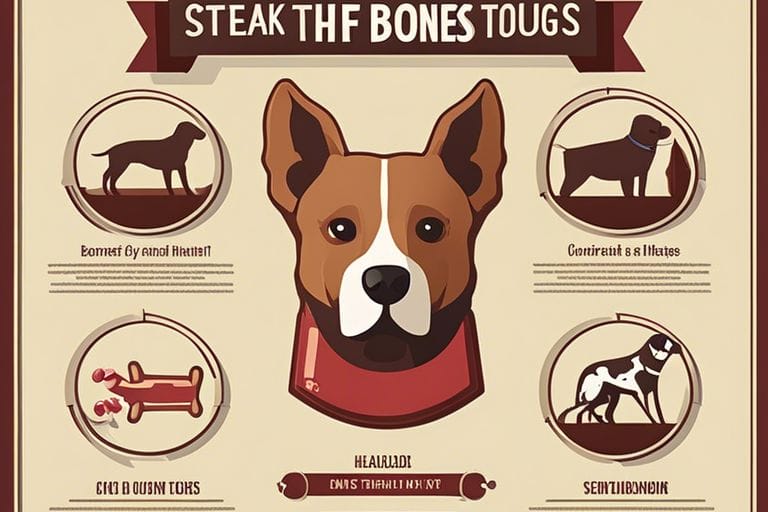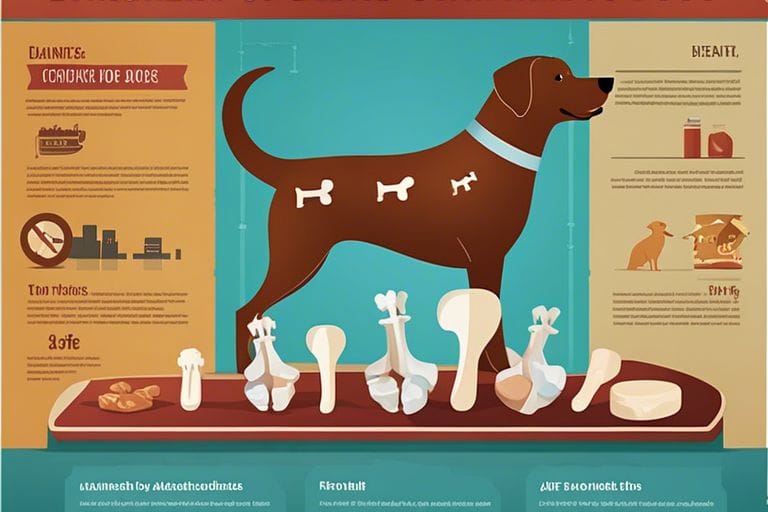Can Dogs Eat Steak Bones? The Risks You Need to Know!
You may be wondering if it’s safe to give your dog leftover steak bones as a treat, but it’s important to understand the potential risks before you make that decision. While it may seem like a natural choice to give your pup a bone to chew on, there are serious dangers associated with feeding your dog steak bones. It’s crucial to be aware of the potential risks and negative effects that steak bones can have on your dog’s health. In this informative blog post, we’ll explore the potential hazards of feeding your dog steak bones and provide you with important information to help you make the best decision for your pet’s well-being.
Key Takeaways:
- Steak bones can pose serious health risks to dogs: The sharp shards from steak bones can cause internal injuries, choking, or obstruction in a dog’s digestive system.
- Alternative options for dogs to chew on: It’s safer to offer dogs raw bones or dog-friendly chew toys to satisfy their chewing instinct without risking their health.
- Consult with a veterinarian before giving steak bones to dogs: To ensure the safety and well-being of your dog, it’s best to seek professional advice from a veterinarian before deciding on any type of bones for your pet.

The Appeal of Steak Bones to Dogs
Some dogs are irresistibly drawn to the savory aroma and enticing texture of steak bones. The rich meaty smell and the satisfying crunch of chewing on a bone can make it an attractive treat for your furry friend. However, it’s important to understand the potential risks associated with feeding steak bones to your dog.
Nutritional Benefits of Bones
While bones can provide some nutritional benefits for your dog, such as being a good source of minerals like calcium and phosphorus, it’s important to note that these benefits can be obtained from safer alternatives like commercial dog chews or supplements. Feeding your dog steak bones for nutritional benefits can be risky due to the potential hazards associated with bone consumption.
Why Dogs Are Attracted to Bones
Dogs are naturally attracted to bones due to their instinctual behavior as hunters and scavengers. Chewing on bones can provide mental stimulation and help satisfy your dog’s natural urge to chew. The appeal of steak bones to dogs lies in the primal instinct to gnaw on bones, but it’s essential to ensure the safety of the bones you offer to your pet.
Potential Risks of Feeding Dogs Steak Bones
Now, you may be wondering if it’s safe to give your dog the leftover steak bones after dinner. While it may seem like a satisfying treat for your furry friend, there are potential risks that you need to be aware of. There is a common debate among dog owners about whether it is safe to feed dogs steak bones. A post on r/Costco discusses the safety of feeding your dog Tomahawk steak bones, highlighting the confusion surrounding this issue.
Choking Hazards
When it comes to steak bones, the risk of choking is a major concern for dogs. The bones can splinter into smaller pieces, which can become lodged in your dog’s throat, causing them to choke. This is a serious and potentially life-threatening situation, so it’s important to carefully consider the size and type of bone before giving it to your dog.
Splintering and Internal Injury
Another risk of feeding your dog steak bones is the potential for splintering and internal injury. Cooked bones are more likely to splinter than raw bones, and these sharp fragments can cause damage to your dog’s mouth, throat, or digestive tract. This can lead to serious health issues and may require emergency veterinary care.
Dental Problems
Feeding your dog steak bones can also lead to dental problems. The hard and dense nature of bones can cause your dog’s teeth to crack or break, leading to pain, discomfort, and possible dental procedures to address the damage. This can be a costly and painful experience for both you and your dog.
Digestive Complications
One of the most significant risks of feeding your dog steak bones is digestive complications. The bones can cause blockages or irritation in your dog’s digestive system, leading to vomiting, diarrhea, or constipation. In severe cases, this can result in a trip to the veterinarian and potential surgery to remove the obstruction.
Safer Alternatives to Steak Bones
After learning about the potential risks of giving your dog steak bones, you may be wondering what safe alternatives you can offer instead. While dogs love to chew and gnaw on bones, it’s essential to find substitutes that won’t pose a danger to their health. Fortunately, there are several safer options that can satisfy your pup’s natural chewing instincts without the hazards associated with steak bones.
Recommended Chew Toys
When it comes to providing your dog with a safe and enjoyable chewing experience, chew toys are an excellent choice. Look for durable toys that are specifically designed for heavy chewers. These toys are made to withstand vigorous gnawing and can help keep your dog entertained for extended periods. Additionally, some chew toys are designed to promote dental health by reducing plaque and tartar buildup. When selecting chew toys, opt for those made of sturdy materials that won’t easily break apart, presenting a choking hazard.
Bone Alternatives and Treats
If you’re looking for alternatives to steak bones, there are plenty of bone-shaped treats and chews available for your dog. Consider options such as synthetic bones, rubber bones, or nylon chews that are designed to withstand heavy chewing. These alternatives can provide a satisfying chewing experience without the risk of splintering or causing injury. Additionally, there are various types of edible treats and chews that can offer a similar texture and flavor to bones, such as bully sticks, dental chews, and natural meat jerky treats. These alternatives can provide a safe and enjoyable chewing experience for your dog, without the potential dangers associated with steak bones.

Best Practices for Bone Safety
Unlike other types of dog treats, it’s crucial to closely monitor your dog when they are enjoying a steak bone. Here are some best practices to ensure your dog’s safety and enjoyment when it comes to bones:
Supervising Your Dog
When giving your dog a steak bone, it’s important to supervise them closely. Make sure that you are present and able to keep an eye on your dog while they chew on the bone. This allows you to intervene if necessary and ensure they are not consuming the bone too quickly or in a dangerous manner. By being present, you can also prevent your dog from being overly aggressive in their chewing, which can lead to splintering and potential choking hazards.
Knowing When to Intervene
While supervising your dog, it’s important to know when to intervene. If you notice that your dog is chewing the bone too aggressively and potentially breaking off small, sharp pieces, it’s time to step in. Additionally, if your dog is trying to swallow a large piece of bone or is showing signs of discomfort or distress, it’s crucial to intervene immediately. Don’t hesitate to take the bone away if you feel that it poses a risk to your dog’s health and safety.
Overall, the key to ensuring your dog’s safety when enjoying a steak bone is close supervision and knowing when to step in if necessary. By following these best practices, you can minimize the risks associated with giving your dog bones and ensure that they can safely enjoy this special treat. Remember to always prioritize your dog’s health and well-being, even when it comes to something as enjoyable as a steak bone.
Can Dogs Eat Steak Bones? The Risks You Need to Know!
To wrap up, it’s important to be aware of the risks associated with giving your dog steak bones. While chewing on bones may provide some dental benefits, they can also pose serious health hazards. The sharp edges of the bone can cause injury to your dog’s mouth, throat, and digestive tract. Additionally, bones can splinter and cause blockages, leading to serious and potentially fatal health issues. It’s important to weigh the potential risks against the benefits and consider alternative options for your dog’s dental health and overall well-being. Consult with your veterinarian to determine the best course of action for your specific dog.
Can Dogs Eat Steak Bones? The Risks You Need to Know!
Q: Can dogs safely eat steak bones?
A: No, dogs should not be given steak bones. Steak bones can splinter and cause serious internal injury to your dog. It is important to never give your dog any type of cooked bones, including steak bones, as they can be dangerous for your pet’s health.
Q: What are the risks of giving my dog steak bones?
A: The risks of giving your dog steak bones include potential choking hazards, damage to the teeth, and intestinal blockages. The splintering of bones can cause lacerations in the mouth and throat, as well as tears in the digestive tract. This can lead to serious health issues and may even require surgery to correct.
Q: Are there any safe alternatives to steak bones for my dog?
A: Yes, there are safe alternatives to steak bones for your dog to enjoy. Consider giving your dog raw, meaty bones like raw chicken or turkey necks, beef ribs, or marrow bones. These types of bones are softer and less likely to splinter, reducing the risks of injury to your dog’s digestive system. Always supervise your dog when giving them a bone and remove any small or sharp pieces to prevent choking or injury.

